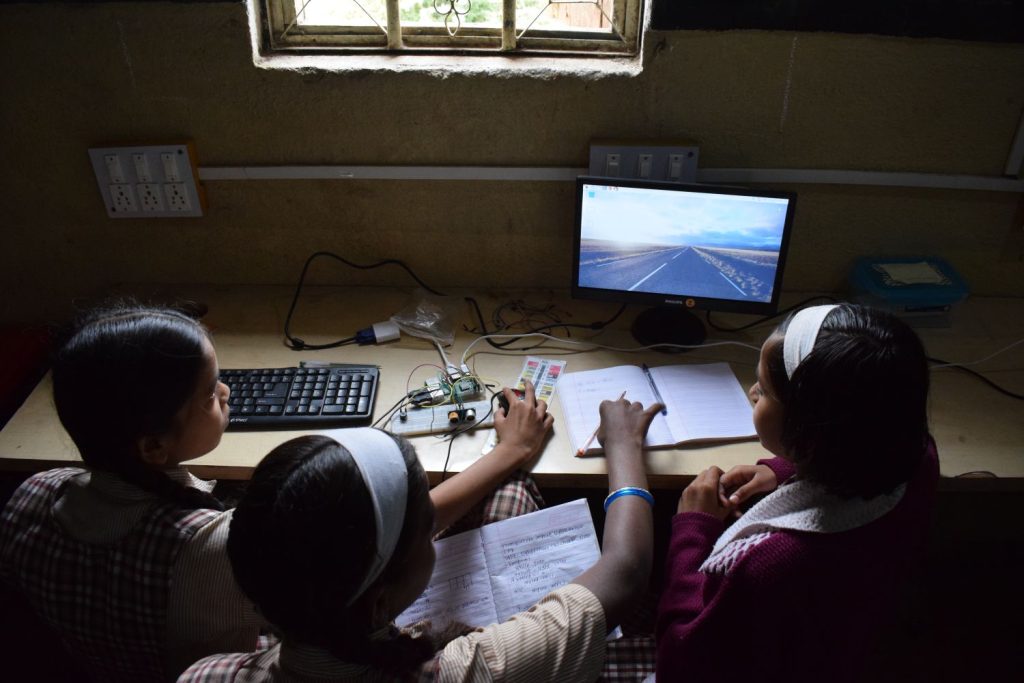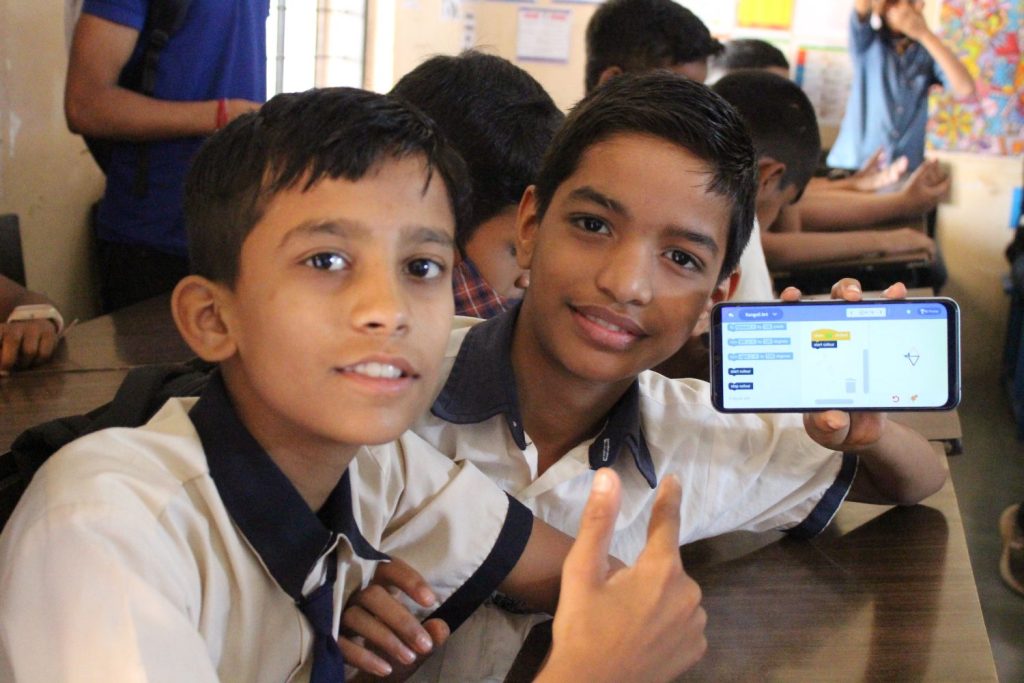The unfolding story of taking computer science learning to the next level
This article discusses important aspects related to continuous professional development (CPD) of teachers, and the need for diversity of perspectives. It also highlights CPD for teachers as a layered practice, and the importance of teacher agency and collaboration in this process.

14-year-old Mushahid Khan is not your regular poster boy for the glossy ed tech ads for “Can your child code?” A student of Mumbai’s Maneklal Municipal Hindi School and a resident of Ghatkopar, he has built a game using opensource software, to raise awareness about child safety for the parents in the neighborhood. Yashoda, an instructor at Pi lab, set up a computer lab in the kitchen of her small house in Ganga Khed, a village in Parbhani, Maharashtra, taking lessons for 25 students through the pandemic. All she needed was a tiny credit-card-sized Raspberry Pi device that doubles up as a central processing unit, and some training.
We have known for a while the sheer power of computer science (CS) education and the impact CS-related skill sets are going to have on the future of our children. CS education is of course critical in terms of opening employment opportunities. Apart from that, through CS, today’s children can meaningfully contribute to the world in the future through their problem-solving, analytical and design-thinking skills. Building competence in computer science also feeds into children’s wide-eyed curiosity. It gives them a sense of comfort and familiarity with the digital landscape, likely to translate into more future opportunities.
NEP 2020 addresses the need to bridge the gap between traditional school learning and the acquisition of practical and future skills. This is a crucial aspect, as the outcomes of school education must lay a strong foundation for children to excel in their future careers and in life, of which CS is emerging as a significant component.
However, a question that begs asking is – have we democratized computer science learning enough? If so, what is the quality of CS learning that we are imparting to students at the bottom of the socio-economic pyramid? How diverse and penetrative is the access to computer science education as it should be taught?
As you will discover in this issue, various non-government organizations along with government agencies (like Government of Goa’s coding and robotics program CARES, or Government of Delhi’s inclusion of future skills-focused courses and curriculum covering AI, machine learning and coding), CSR entities and big-tech (a hat tip to the work being done by companies like Amazon through its Amazon Future Engineer initiative, and CGI) are working dedicatedly with educationists in this direction.

These varied sets of actors are making and driving policies, framing pedagogies that integrate CS learning in ways that develops specific future skills in children. These include computational thinking, design thinking (identifying problem around to charting out the best solution path), analytical problem solving, creativity and logical reasoning. In other words, the attempt now is to make quality CS learning available to every child, so that no child gets left behind in having a place at the table when an inclusive, solution-centric, imaginative tech-driven future is being shaped. There are challenges, like the demography, reach, infrastructure, advocacy and awareness. However, solutions are in sight too!

NEP 2020 envisages a shift to a system where, “Children not only learn but more importantly learn how to learn.” It goes on to say that the “pedagogy must evolve to make education more experiential, inquiry-driven, flexible,” an acknowledgment that has given a boost to our approach to computer science learning. If voices from the ground that you’ll read in the ‘Insights’ section of this issue of Samuhik Pahal are anything to go by, the results are reassuring.
To make education and learning outcomes more effective, educationists are making a case for children to learn coding early, like languages and arithmetic. Programming has been encouraged as a tool to introduce computational thinking, which means to think or look at a problem like a computer scientist. As a researcher points out in this issue, scientists further argue that although computational thinking represents an excellent starting point, the broader conception of ‘computational participation’ better captures the twenty-first-century reality.
As Dr Chintan Vaishnav, Director, Atal Innovation Mission (AIM) shares in an interview in the issue, “When you look at school labs, there have been two waves before the makers’ lab wave, the science labs wave and the computer labs wave, which are very different from each other. The makers’ lab was possibly the first time that both minds and hands were involved. In science labs, they prove what is known, in computer labs, they digitize what is not digital, and in makers’ labs, they create thoughts!”
Cases in point – using technology to grow plants with minimal human intervention; building local weather systems; writing codes to automate irrigation pumps for farmers, and; building motion sensors to read potholes based on pothole data repositories – low-cost, scalable computer science education is helping children relate computational learning with their social realities and problems, apart from implementing scientific and mathematical concepts they learn in their regular classes.
We must create a generation of kids who are computational thinkers, problem solvers, design thinkers, innovators and analysts, and not merely good at a particular skill subset, namely coding in this case. Various initiatives, including Nipun Bharat, have offered to fill the lacunae in the Indian education system, influencing the prospects and design of NEP 2020. The COVID-19 pandemic has essentially thrust technology into the hands of everyone. While the educational technology sector has been at the center of this transition, distinct gap remains between access, agency and utilization of the tools. More access, while needed, does not alone ensure cultivation of agency for learning and problem solving or indeed improvement in learning outcomes.
There is a need to delve into the essence of education itself, to understand the quality of outcome in the above context. Education, in its truest sense, has two dimensions. The first pertains to skills and the job economy, where education aligns with future career prospects. The second dimension delves into the elevation of the human soul, the cultivation of agency, and empowerment.
Can the children think on their own? Can children use digital tools to solve the problems they observe in their environment? In this modern age, technology has now been seamlessly integrated into our daily existence, influencing the way we interact with the world. But not every learner has been able to exploit this integration to her best potential, just yet.
This is where what we do in the field of CS education as part of the educational overhaul becomes so important. It’s not just about technology proficiency. It is about cultivating agency in the digital era. The creative dimension becomes paramount for children’s development, as creativity takes various forms and is instrumental in participatory problem-solving and critical thinking. Computer Science doesn’t merely provide comfort with technology. It serves as a catalyst for nurturing creativity, honing logical problem solving skills, and facilitating an understanding of the world. Against this backdrop, the role of nonprofit agencies dedicated to improving access and quality of digital education in India is critical to ensure that children are equipped with 21st century digital skills. Our mission must be to democratize computer science learning across the entire country, along with building agency, nurturing problem-solving and creative skills in learners.
The essence of agency varies from a school in Kupwara (in Jammu and Kashmir) to a crowded school in BMC (Brihanmumbai Municipal Corporation, or Municipal Corporation of Greater Mumbai). Similarly, the stories of teachers adopting computer science learning modules, and using low-cost tech to do the same as part of their teaching armors, is inspiring. It showcases the shift from mere digital access to its effective utilization. It is about acknowledging that having access to technology is not enough. It is about integrating it into students’ learning experiences. This is where nonprofit organizations must step in, creating a bridge between technology, creativity and education, ensuring that the digital realm becomes a tool for empowering young minds, across the socio-economic spectrum.




No approved comments yet. Be the first to comment!